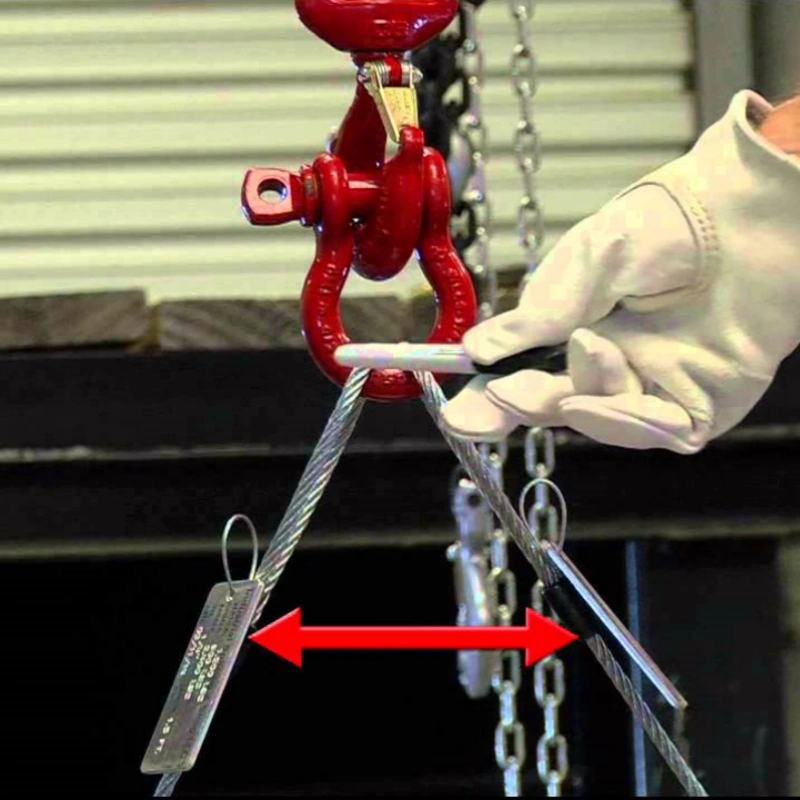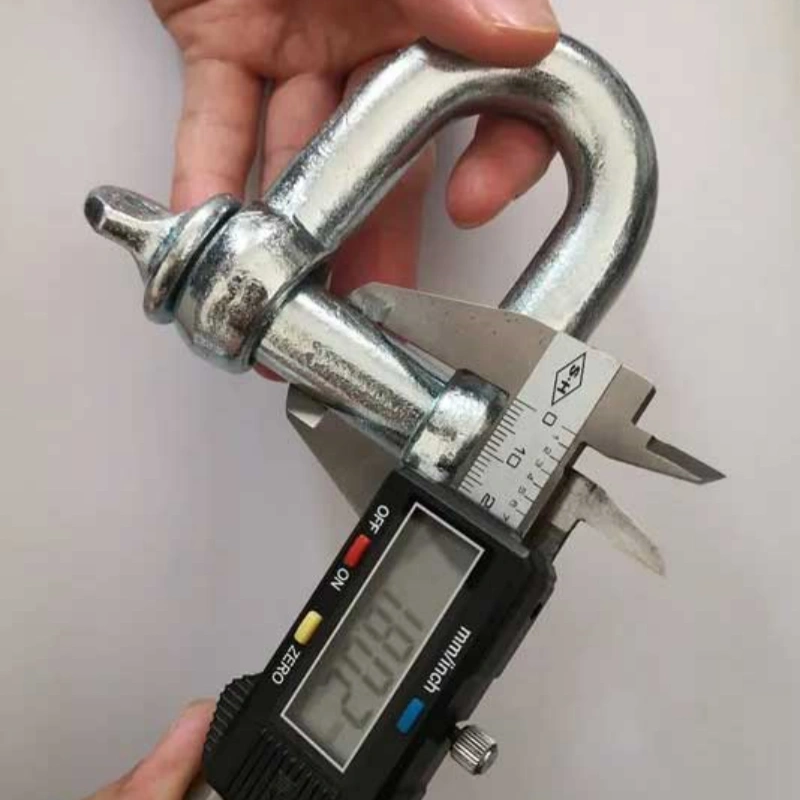You need to understand what sets a lifting chain vs a tie-down chain apart to keep your workplace safe and efficient. Choosing the wrong chain can lead to costly accidents. In 2023, over 2.6 million nonfatal workplace injuries and illnesses were reported, with load drops due to poor rigging practices making up 27% of incidents.
Source | Statistic | Description |
|---|---|---|
U.S. Bureau of Labor Statistics (BLS) | Over 2.6 million | Nonfatal workplace injuries and illnesses reported in 2023. |
National Safety Council (NSC) | $43,000 | Average cost of a workplace injury. |
Konecranes Training Institute | 27% | Load drops are tied to poor rigging practices. |
Environmental conditions play a big role when you select chains. Powerful Machinery offers certified lifting and transport solutions to help you choose the right chain for your needs.
Key Takeaways
Lifting chains are designed for overhead lifting and must meet strict safety standards. Always use them for moving heavy loads safely.
Tie down chains secure cargo during transport and are not suitable for lifting. Using them incorrectly can lead to serious accidents.
Check the grade and working load limit of chains before use. This ensures you select the right chain for your specific task.
Regularly inspect your chains to prevent accidents. Follow safety guidelines to keep your workplace safe and compliant.
Consult experts like Powerful Machinery for certified products and advice on choosing the right chain for your needs.
Key Differences
Lifting Chain vs Tie Down Chain
When you compare lifting chains vs tie-down chains, you see that each serves a unique purpose in your workplace. Lifting chains handle overhead lifting tasks. You use them to raise, lower, or move heavy loads safely.
These chains must meet strict safety standards because they support the full weight of the load above ground. You often find them in construction, manufacturing, and marine industries.
Tie-down chains, on the other hand, secure cargo during transport. You use them to keep loads in place on trucks, trailers, or flatbeds. These chains do not lift loads off the ground.
Instead, they prevent movement during transit. Industry standards do not allow you to use a tie-down chain for lifting because it does not meet the safety requirements for overhead lifting.
The main difference comes down to function and safety. Lifting chains must meet higher safety standards and use stronger materials. Tie-down chains focus on holding loads in place, not lifting them. If you use the wrong chain, you risk accidents, injuries, or damage to your cargo.
Powerful Machinery provides both lifting and tie-down solutions. You can trust their certified products to meet your specific needs, whether you need to lift heavy equipment or secure cargo for transport.
Quick Comparison
You can quickly see the differences between the lifting chain vs the down chain in the table below:
Chain Type | Grade | Intended Use | Safety Standards Required |
|---|---|---|---|
Lifting Chains | Grades 80, 100, 120 | Overhead lifting | Yes |
Tie Down Chains | Securing loads during transport | No |
Tip: Always check the grade and intended use before choosing a chain. Using the right chain keeps your workplace safe and your cargo secure.
When you face the choice of a lifting chain vs a tie-down chain, remember that each chain has a specific job. Lifting chains handle the stress of overhead lifting. Tie-down chains keep your loads steady during transport.
Powerful Machinery offers both types, so you always have access to certified, high-quality chains for any application.
Lifting Chains
What is a Lifting Chain?
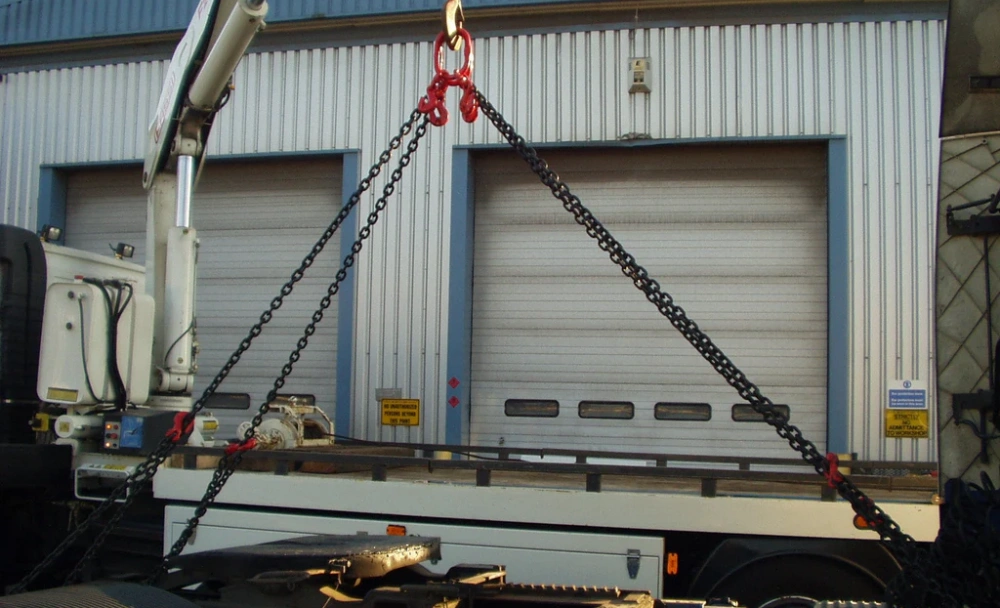
You use a lifting chain when you need to move heavy or awkward loads safely. These chains are made from high-strength alloy steel and are built to handle tough jobs. Each link is tested for load capacity, so you can trust the chain to hold up under pressure.
Lifting chains stand out because they resist cuts and abrasions, and they keep their strength even in high temperatures—up to 400 degrees Fahrenheit. This makes them a top choice for demanding industrial environments.
Characteristic/Use | Description |
|---|---|
Strength and Longevity | Made from Grade 100 or higher alloy steel, offering about 25% more strength than Grade 80 slings. |
High Temperature Tolerance | Maintains strength in environments up to 400°F. |
Cut and Abrasion Resistance | Built to resist damage, abrasions, and general wear. |
Versatility | Flexible for a wide range of lifting and rigging tasks. |
Safety | Each link is tested for load capacity, meeting strict safety standards. |
Lifting Applications
You will find lifting chains in many industries. They are used for overhead lifting, rigging, and moving heavy or oddly shaped materials. Construction sites, shipyards, and factories rely on these chains every day. Their strength and flexibility let you handle loads that other slings cannot.
You can use them in hot, dirty, or rough conditions without worrying about failure. Each chain meets strict safety standards, such as ANSI, NACM, ASTM, and OSHA, so you know your lifting operations stay safe and compliant.
Note: Chain slings must undergo regular inspections and certification to meet both local and international regulations, including ASME B30.9 and ISO standards.
G80 Lifting Chain by Powerful Machinery
Powerful Machinery’s G80 Lifting Chain gives you a reliable solution for your toughest lifting jobs. This chain is made from high-quality alloy steel and is heat-treated for extra durability. It handles heavy-duty lifting tasks with ease and stands up to harsh environments.
Each chain is proof-tested to 2.5 times its working load limit, so you get peace of mind with every lift.
Feature/Advantage | Description |
|---|---|
High Strength | Handles heavy-duty lifting tasks with superior strength. |
Durability | Made from high-quality alloy steel for long-lasting performance. |
Safety Features | Rigorously tested to meet strict safety standards. |
Versatility | Suitable for many applications and customizable to your needs. |
Improved Efficiency | Lighter weight and innovative design make handling easier. |
Economical | Strong chains reduce maintenance costs and offer long-term value. |
You can count on Powerful Machinery’s G80 Lifting Chain to meet or exceed international standards. It comes with full certification and documentation, so your lifting operations always stay safe and efficient.
Transport Chains
What is a Transport Chain?
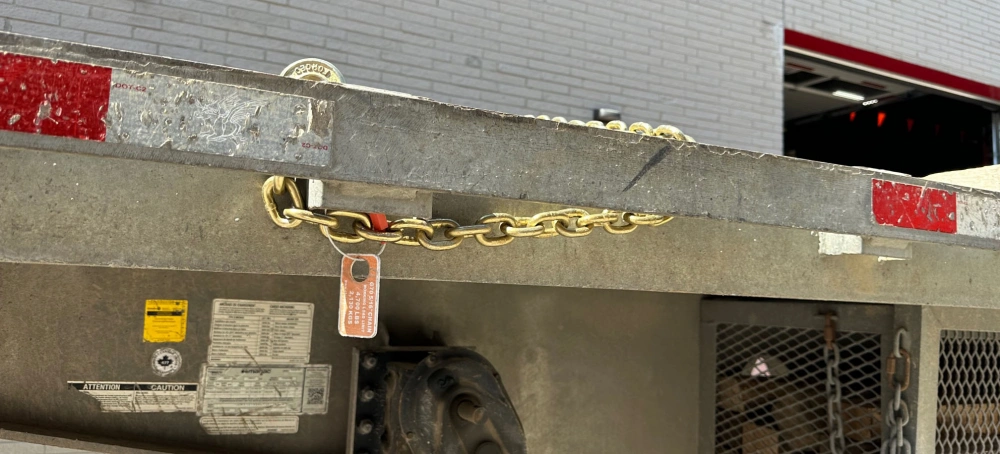
You use a transport chain when you need to keep heavy loads in place during transit. A transport chain is not designed for lifting. Instead, it works as a strong link between your cargo and the vehicle, making sure nothing shifts or falls.
Most transport chains are made from heat-treated carbon steel, which gives them the strength needed for tough jobs. You often see a transport chain paired with load binders to tie down equipment, machinery, or building materials. This combination helps you achieve proper load securement every time you move goods.
Tie Down Applications
Transport chains play a key role in shipping and logistics. You rely on them to tie down loads on trucks, trailers, and even ships. In maritime transport, which handles over 90% of global trade, a transport chain helps secure bulk materials and large-volume goods.
You find transport chains in industries like manufacturing and automotive, where cargo securement is critical for safety and efficiency. When you use a transport chain with load binders, you can tie down raw materials, finished products, or heavy machinery. This keeps your cargo stable, even on rough roads or at sea.
Transport Mode | Common Applications | Benefits |
|---|---|---|
Maritime | Bulk carriers for raw materials, container ships for manufactured products | Cost-effective for large volumes, high carrying capacity |
Tip: Always use the right transport chain and load binders for your tie-down needs. This ensures proper load securement and prevents costly accidents.
Grades and Standards
You must choose the correct grade of transport chain for your tie-down job. Grade 70 is the most common grade for the transport chain. It is made from heat-treated carbon steel and is designed for load securement, towing, and logging.
Grade 70 transport chain is strong enough for tie-down tasks but not for overhead lifting. You should never use a transport chain for lifting because it does not meet the safety standards required for that purpose.
Chain Grade | Material | Strength | Applications | Overhead Lifting |
|---|---|---|---|---|
Grade 70 | Heat-treated carbon steel | Standard | Tie-downs, towing, logging | No |
Grade 80 | Heat-treated steel | High strength | Recovery, safety, towing | Yes (with hooks) |
Grade 100 | Premium quality steel | 25% higher | Overhead lifting, securing loads | Yes |
Grade 120 | High-performance steel | 50% higher | Overhead lifting | Yes (with hooks) |
You should always use load binders with your transport chain to tie down your cargo securely. This practice keeps your load safe and meets industry standards for load securement.
Materials & Construction
Alloy Steel for Lifting
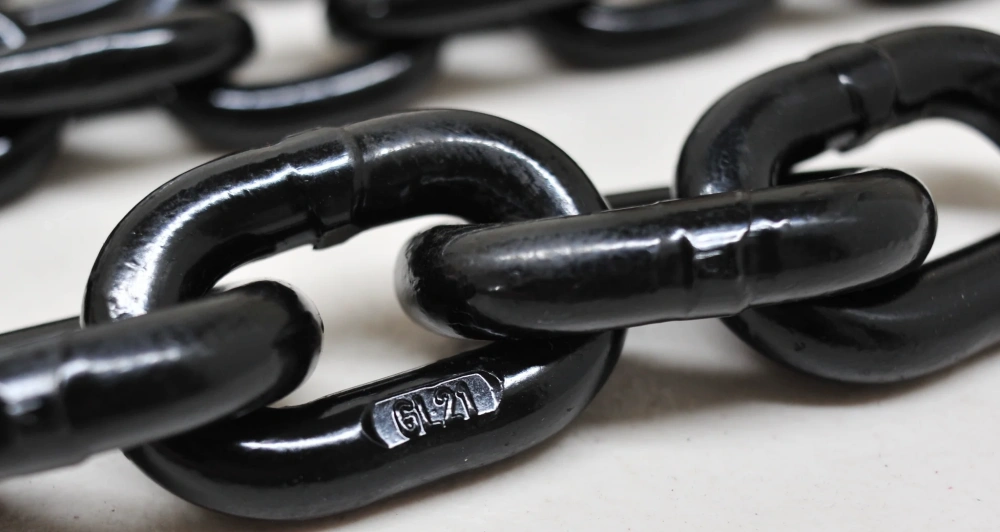
When you choose a lifting chain, you need to look at the material and how it is made. Lifting chains must handle heavy loads and tough conditions. Manufacturers use high-strength alloy steel because it gives you the best mix of strength, durability, and safety.
Powerful Machinery uses advanced heat treatment to make sure each chain link can take on the toughest jobs.
You will find several types of alloy steel used in lifting chains:
Alloy Steel Grade 80: This grade stands out for its excellent strength-to-weight ratio. It works well for lifting and rigging. You get resistance to abrasion and corrosion, which means longer service life.
Alloy Steel Grade 100: This is the strongest grade you will see in lifting chains. It offers higher working load limits than Grade 80. You can use it for the most demanding lifting tasks.
Alloy Steel Grade 70: While this grade is strong and heat-treated, it is mainly for securing loads during transport, not for overhead lifting.
Powerful Machinery’s G80 Lifting Chain uses heat-treated alloy steel. The heat treatment process, which includes quenching and tempering, boosts the chain’s toughness and reliability. Each chain is tested to make sure it meets strict safety standards.
Materials for Transport Chains
Transport chains, also called tie-down chains, use different materials and construction methods.
You will often see Grade 70 chains made from carbon steel. These chains are strong enough to secure heavy cargo, but they do not go through the same heat treatment as lifting chains. This means they are not safe for overhead lifting.
Here is a quick comparison of materials and processes:
Chain Grade | Material | Heat Treatment Process | Applications |
|---|---|---|---|
G80 | Heat-treated alloy steel | Yes | Overhead lifting, marine environments |
Grade 70 | Carbon steel | No | Transport chains, towing |
Grade 100 | Heat-treated alloy steel | Yes | Heavy lifting, high-stress applications |
When you select a chain, always match the material and construction to your job. Lifting chains need high-strength alloy steel and advanced heat treatment. Transport chains use carbon steel and focus on holding loads in place.
Powerful Machinery ensures every lifting chain meets or exceeds international standards, giving you confidence in every lift.
Strength & Ratings
Working Load Limits
You need to know the working load limit for every chain you use. This number tells you the maximum weight a chain can safely handle. Lifting chains and tie-down chains have different working load limits, even if they look similar in size.
Lifting chains, like Grade 80 and Grade 100, go through special heat treatment. This process gives them higher strength and makes them safe for overhead lifting. Tie-down chains, such as Grade 70, are strong enough to secure cargo but not safe for lifting.
Here is a quick comparison:
Chain Grade | Typical Use | Working Load Limit Characteristics |
|---|---|---|
Grade 70 | Tie down chains | Not suitable for overhead lifting; used for securing loads. |
Grade 80 | Lifting chains | Suitable for overhead lifting; heat-treated for strength. |
Grade 100 | Premium lifting chains | Offers 25% higher WLL than Grade 80; safe for overhead lifting. |
Tip: Always check the working load limit stamped on the chain or tag. Never guess. Using a chain above its rated limit can cause accidents.
Safety Factors
Safety factors add another layer of protection. Manufacturers design lifting chains with a safety factor, often 4:1. This means the chain can handle four times its working load limit before breaking.
Tie-down chains do not need the same safety factor because they do not lift loads overhead. You must never use a tie-down chain for lifting, even if it looks strong.
Powerful Machinery takes safety seriously. Every lifting chain goes through strict testing and certification. You can expect:
A trained user inspects the chain before each use.
A competent person performs a full inspection at least once a year, with results documented.
Inspection frequency depends on how you use the chain:
Inspection Type | Frequency |
|---|---|
Normal Service | once annually |
Severe Service | once monthly to quarterly |
Special Service | as recommended by a qualified person |
Maximum Interval | should never exceed one year |
You protect your team and your cargo when you follow these safety steps. Powerful Machinery’s certified chains give you confidence that every lift or tie down meets the highest standards.
Safety & Compliance
Lifting Chain Standards
You must follow strict safety standards when you use lifting chains. These standards protect you and your team during every lift. Organizations like OSHA, ASME, NACM, and ASTM set the rules for lifting equipment. Each group focuses on a different part of the chain safety, from materials to testing.
Standard | Description |
|---|---|
OSHA | Ensures compliance with safety regulations for lifting equipment. |
ASME B30.9 | Requires proofloading of alloy lifting chain assemblies before initial use. |
NACM | Specifies chain specifications and requirements for safe use. |
ASTM | Sets standards for materials and performance of chains used in lifting. |
You need to check that your lifting chains meet these requirements before every job. Powerful Machinery’s G80 Lifting Chain meets or exceeds all major safety standards. The chain holds certifications such as DIN EN818-2, NACM, ASTM, and ISO 4-to-1.
These certifications show that the chain is built for heavy-duty lifting and maximum safety.
Note: Always look for proof of certification when you select a lifting chain. This step helps you avoid accidents and keeps your workplace safe.
Transport Chain Standards
Transport chains, or tie-down chains, must also meet important safety standards. The Department of Transportation (DOT) and NACM set the main rules for these chains. You need to use chains that match the NACM Welded Steel Chain Specifications. These rules cover how chains are made, marked, and inspected.
Compliance Requirement | Description |
|---|---|
NACM Specifications | All chains used for load securement must conform to NACM Welded Steel Chain Specifications, which detail manufacturing, dimensions, markings, and inspection standards. |
The Working Load Limit (WLL) is the maximum load you can safely apply to a cargo securement component.
The total WLL for your tie-downs must be at least half the weight of the equipment you transport.
Powerful Machinery’s transport chains meet or exceed these safety standards. You can trust their products to keep your cargo secure and your operations compliant.
Tip: Never use a transport chain for lifting. Always check the chain’s markings and certifications before use.
Choosing the Right Chain
Assessing Your Needs
You need to match the right chain to your job. Start by looking at what you plan to do. If you want to lift heavy loads overhead, you must use a lifting chain. If you need to secure cargo for transport, a tie-down chain works best. Each chain type has its own strengths and safety rules.
Check these important factors before you choose:
Factor | Description |
|---|---|
Chain Grades | Different grades show the strength and best use for each chain. |
Breaking Load | This is the most force a chain can handle before it breaks. |
Working Load Limit (WLL) | The highest weight you can safely lift or secure with the chain. |
Environmental Conditions | Think about heat, moisture, and chemicals that may affect the chain. |
Specific Application Needs | Some jobs need special chain designs, like single-leg or multi-leg slings. |
You also need to know the chain grade. Here are some common grades and their uses:
Grade 30: Good for light work in construction or farming.
Grade 43: Used for towing and marine jobs.
Grade 70: Best for securing heavy loads on trucks.
Grade 80: Made for overhead lifting and tough towing.
Grade 100: Handles the heaviest lifting and big construction tasks.
Tip: Always check the chain’s markings and paperwork. Make sure the chain matches your job and meets safety standards.
Common Mistakes
Many people make mistakes when choosing chains. You might pick a chain that looks strong but is not rated for your task. Using a tie-down chain for lifting is dangerous. It can break and cause accidents. Never use a lifting chain for transport if it does not fit your cargo needs.
Some skip checking the working load limit or ignore the chain’s grade. Others forget to think about weather or chemicals that can weaken the chain. These mistakes put your team and cargo at risk.
You can avoid these problems. Always read the chain’s label and follow the rules for your job. If you feel unsure, ask an expert. Powerful Machinery offers advice and certified products for both lifting and transport. Their team helps you pick the safest and most effective chain for your needs.
Note: The right chain keeps your workplace safe and your cargo secure. When in doubt, reach out to Powerful Machinery for expert help.
Why the Distinction Matters?
Safety Risks
You face serious risks when you use the wrong chain for a job. If you use a tie-down chain for lifting, you put your team and equipment in danger. Lifting chains and tie-down chains have different strengths and safety features. Using the wrong one can lead to accidents, injuries, or even deaths.
Here are some common safety risks you might encounter:
Safety Risk | Description |
|---|---|
Failing to Inspect Chains Regularly | Neglecting inspections can lead to unnoticed damage, increasing the risk of accidents. |
Improper Storage of Lifting Chains | Poor storage can cause corrosion and degradation, compromising the chain’s integrity. |
Incorrect Hooking and Attachment | Improper attachment can weaken the grip, leading to slips and accidents. |
Ignoring Load Balancing | Uneven weight distribution can cause instability and unexpected load shifts during lifting. |
Using Damaged or Mismatched Components | Using inferior or incompatible parts can compromise the entire lifting system’s safety. |
Not Following Safety Guidelines | Ignoring safety regulations can lead to serious incidents during lifting operations. |
Tip: Always inspect your chains, store them properly, and follow all safety guidelines. These steps help prevent accidents and keep your workplace safe.
Legal & Cost Implications
Choosing the wrong chain does not just risk safety—it can also hurt your business. If you do not follow industry standards, you may face legal trouble and high costs.
You could pay fines that exceed $1 million.
Criminal charges may result from breaking safety rules.
Regulatory agencies might revoke your licenses or stop your operations.
Your business could suffer from operational disruptions.
A damaged reputation can make it hard to keep employees and customers.
Improper chain selection also increases your costs in other ways:
Overstocking the wrong chains raises storage expenses.
Stockouts can lead to lost sales and unhappy customers.
Missed deadlines disrupt your logistics and production.
When customers learn about unsafe or unsustainable practices, they often hold your company responsible. This can lead to consumer anger, boycotts, and even higher costs for your business.
You protect your team, your reputation, and your bottom line when you choose the right chain and follow all safety standards. Always select certified products and consult experts like Powerful Machinery to ensure compliance and safety.
Conclusion
You now know the main differences between lifting chains and transport chains.
Grade 70 chains secure cargo during transport and are not for lifting.
Grade 80 and Grade 100 chains handle overhead lifting and heavy-duty jobs.
Transport chains prevent load shifts and protect your assets.
Always inspect your chains, match the chain grade to your task, and follow safety guidelines. For certified, high-performance solutions, trust Powerful Machinery to keep your workplace safe and efficient.
FAQ
What happens if you use a tie-down chain for lifting?
You risk serious accidents. Tie-down chains do not meet the strength or safety standards for lifting. Always use certified lifting chains for overhead tasks.
How do you identify the grade of a chain?
Look for grade markings stamped on the chain links. You can also check the manufacturer’s tag or documentation. Grades 70, 80, and 100 are the most common.
Can you use a lifting chain for securing cargo?
You can use a lifting chain for tie-down in some cases, but it is not cost-effective. Lifting chains are stronger and more expensive. Use the right chain for each job.
How often should you inspect your chains?
You should inspect chains before each use. Schedule a thorough inspection at least once a year. Increase inspection frequency if you use chains in harsh conditions.
Where can you get certified lifting and transport chains?
You can get certified chains from Powerful Machinery. Visit Powerful Machinery’s website for high-quality, tested products and expert advice.

